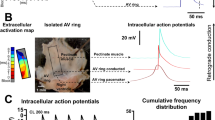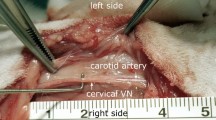Abstract
The tunica media of the pulmonary vein (PV) in many mammalian species, including man, is made up of cardiac muscle1–3. Brunton and Fayrer first reported that independent pulsation of the PV occurred in cats and rabbits even after activity of the heart had ceased4. Electrophysiological studies have also shown spontaneous electrical activity in isolated PVs of the guinea pig and a pacemaking region has been located at the distal end of the cardiac portion of the vein adjoining the smooth muscle. The intrinsic frequency of the PV was low and activity at the PV was normally coupled to the sinus rhythm5. Thus, the PV behaves as a subsidiary pacemaker. In the presence of digitalis-type agents, subsidiary pacemakers such as Purkinje fibres develop oscillatory afterpotentials (OAPs) which may be large enough to reach threshold6,7, and it has been suggested that OAPs at Purkinje fibres leading to spontaneous action potentials may provide the underlying mechanism for ventricular arrhythmia during digitalis intoxication6. In contrast, atrial and ventricular muscles are not very sensitive to the arrhythmogenic action of digitalis8. I have therefore now investigated whether the PV can develop OAPs and act as an ectopic focus with digitalis intoxication. By recording with intracellular microelectrodes simultaneously at the PV and right atrium, I demonstrate that OAPs and repetitive activity develop at the PV in the presence of ouabain. Propagation of these triggered action potentials at the PV into the atrium results in atrial extrasystoles.
This is a preview of subscription content, access via your institution
Access options
Subscribe to this journal
Receive 51 print issues and online access
$199.00 per year
only $3.90 per issue
Buy this article
- Purchase on Springer Link
- Instant access to full article PDF
Prices may be subject to local taxes which are calculated during checkout
Similar content being viewed by others
References
Spach, M. S., Barr, R. C. & Jewett, P. H. Am. J. Cardiol. 30, 844–854 (1972).
De Almeida, O. A., Bohm, G. M., De Paula Carvalho, M. & De Carvalho, A. P. J. Morph. 135, 409–434 (1975).
Kramer, A. W. Jr & Marks, L. S. J. Morph. 117, 135–150 (1965).
Brunton, T. L. & J. Proc. R. Soc. B25, 174–176 (1876).
Cheung, D. W. J. Physiol., Lond. 314, 445–456 (1981).
Ferrier, G. R., Saunders, J. H. & Mendez, C. Circulation Res. 32, 600–609 (1973).
Ferrier, G. R. Prog. cardiovasc. Dis. 19, 459–474 (1977).
Hashimoto, K. & Moe, G. K. Circulation Res. 32, 618–624 (1973).
Kass, R. S., Tsien, R. W. & Weingart, R. J. Physiol., Lond. 281, 209–226 (1978).
Author information
Authors and Affiliations
Rights and permissions
About this article
Cite this article
Cheung, D. Pulmonary vein as an ectopic focus in digitalis-induced arrhythmia. Nature 294, 582–584 (1981). https://doi.org/10.1038/294582a0
Received:
Accepted:
Issue Date:
DOI: https://doi.org/10.1038/294582a0
This article is cited by
-
Electrophysiological characteristics of the rat azygos vein under electrical pacing and adrenergic stimulation
The Journal of Physiological Sciences (2018)
-
Nitroprusside modulates pulmonary vein arrhythmogenic activity
Journal of Biomedical Science (2010)
-
Radiofrequency catheter ablation of atrial fibrillation initiated by spontaneous ectopic beats
Current Cardiology Reports (2000)
Comments
By submitting a comment you agree to abide by our Terms and Community Guidelines. If you find something abusive or that does not comply with our terms or guidelines please flag it as inappropriate.



